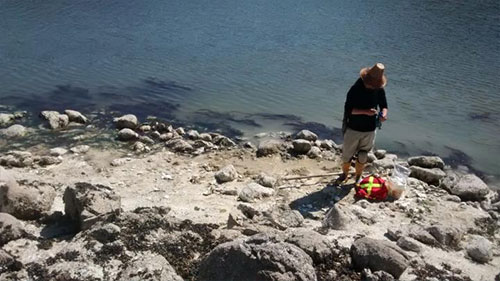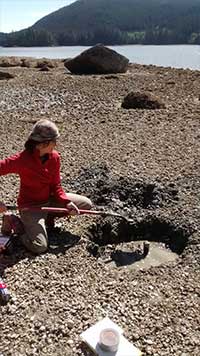
3,500 years of shellfish farming by indigenous peoples on the Northwest coast
February 28, 2019
The study reveals that clam gardens, ancient Indigenous food security systems located along B.C.'s coast, date back at least 3,500 years - almost 2,000 years older than previously thought. These human-built beach terraces continue to create habitat for clams and other sea creatures to flourish in the area. For thousands of years, First Nations of the Northwest Coast, from Alaska to Washington, relied on clams as a staple food. Clam gardens have helped Indigenous peoples prevent the depletion of this important food resource despite ongoing harvesting to support the growth of dense and widespread human populations.
Clam gardens are traditional mariculture structures consisting of a rock wall and flat terrace that serve as a sheltered habitat for clams in intertidal zones of beaches. It is known that these gardens increase clam productivity and abundance and have long been important food sources for coastal Indigenous cultures. However, since clam gardens often have complex formation histories, they can be difficult to date, and it is thus difficult to track mariculture trends through time. "This traditional form of mariculture has been used continuously for 3500 years and into the present day, and it holds potential to become a model for how local, sustainable food systems could operate in the future," says Nicole Smith. "Oral traditions, songs, and local Indigenous knowledge, as well as the archaeological record indicate that clam gardens were built and used throughout the coast," says Dana Lepofsky. "However, because clam gardens are constructed of rock, it is difficult to determine the age of these features using standard archaeological techniques. "The findings in this study provide unequivocal evidence for long-term and sustainable management of coastal ecosystems by Northwest Coast peoples -- and supports what they have always said about their traditional marine management practices," says Lepofsky. In this study, Smith, Lepofsky, and colleagues surveyed nine ancient clam gardens on Quadra Island, British Columbia. At each site, they identified suitable samples for constraining the age of construction of the gardens, focusing on shell samples from within or beneath the garden walls and beneath the terraces. In total, they collected 35 radiocarbon dates on the shells of clams, snails, and barnacles ranging from at least 3,500 years ago to the 20th Century. The authors also corroborated their dates with data on the regional history of sea level change, and with dates from other marine management features in the region. They provide a set of guidelines for determining accurate ages of three different forms of clam gardens, which they hope will allow for more detailed tracking of mariculture history in the Americas. They note, however, that their methods are only a start, and will likely require fine-tuning at clam gardens and other mariculture sites from different regions and ages. The authors add: "By documenting that clam gardens are at least 3,500 years old, this study supports what coastal First Nations of the Pacific Northwest have always known: managing clams, in the form of clam gardens, is an age old practice and fundamental to long-term food security."
On the Web:
Editing by Mary Kauffman, SitNews
Source of News:
|
|||||

